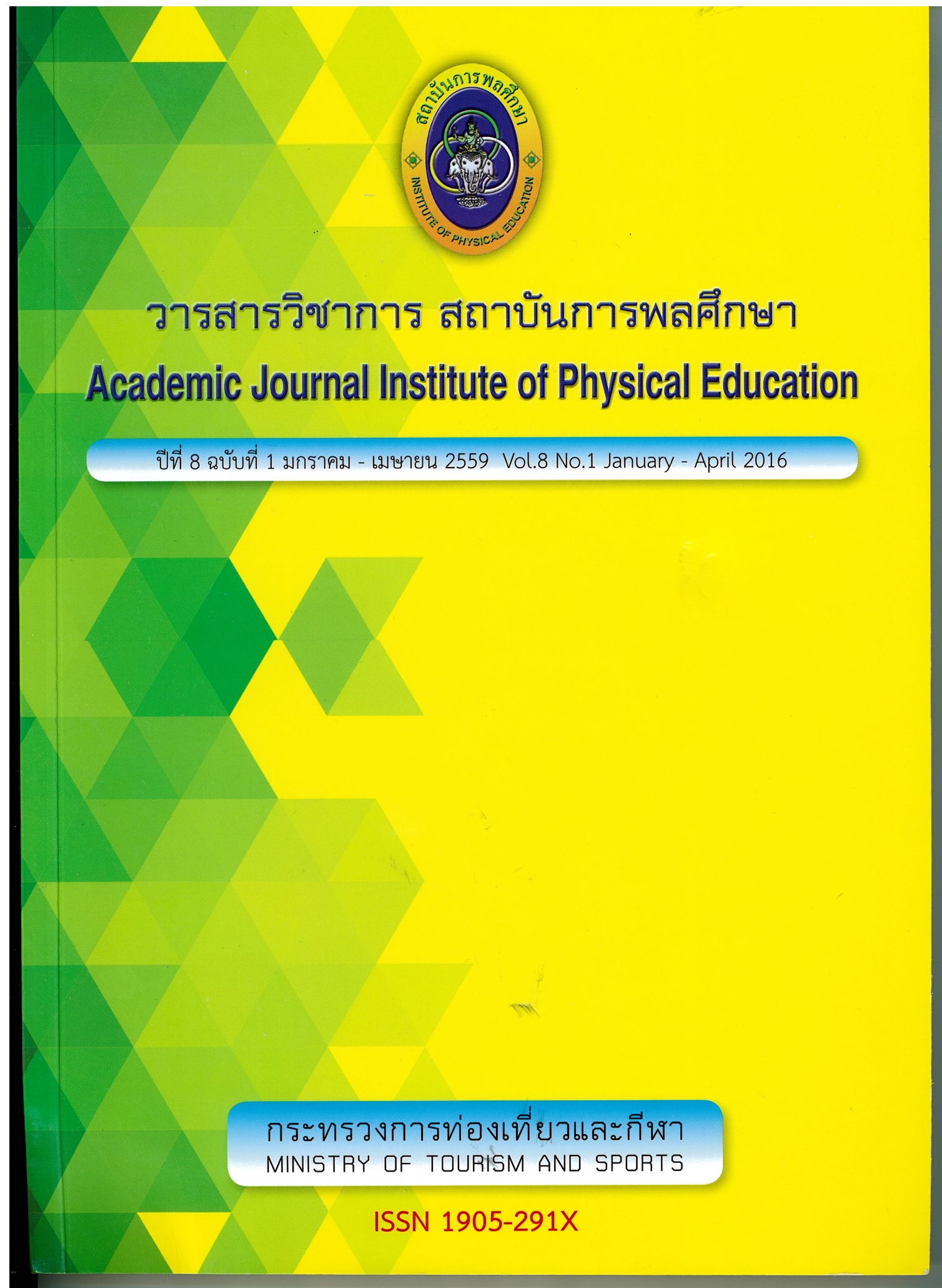Exercise behaviors of people in Krabi Province
Main Article Content
Abstract
This research aimed to study the exercise behavior and the relationship between personal characteristic and exercise behavior of the people in Krabi province. The sample in this study was 400 Krabi people from the total number of the population (432,704 people), from the eight districts, using simple random sampling method according to the calculated sample size in each district. Instrument used in this research was open-ended and five-scales rating questionnaire. The questionnaire was tested for content validity and reliability utilizing the Cronbach's coefficient alpha with the equivalence of 0.96. Percentage distribution was applied to determine the general individual data; descriptive statistics for evaluating exercise behavior. Cross tabulation was employed to investigate the relationship between personal characteristics and exercise behavior of the people in Krabi province. The results according to the data analysis were reported with table and description.
Summary of findings: 53.3% of the participants were male and 46.7% of them were female. Most of the participants aged between 26-45 years old, lived in Krabi town, highest degree of education was in high school level and had own business. The participants' opinions towards exercise were that people needed to exercise regularly to keep strong and healthy, exercise was a fun activity, and they would like to exercise regularly at the highest level. The participants were aware of the benefits of exercise that it supported the body systems, enhanced sound mind, built immunity, and enhanced good personality at the highest level. The participants were knowledgeable about exercise; they conducted themselves before and after exercise properly, chose proper kind of exercise for their own conditions, knew how to properly exercise, knew various forms of exercise to avoid boredom, knew the precautions in the exercise, and wore appropriate clothes for each exercise at a high level, respectively. The participants knew how to exercise; they exercised for 20-30 minutes at a time and always relaxed the muscles after exercise at the highest level. The participants found some barriers in exercise; they could not exercise because there was no place available including not having coach or adviser at a high level.
Article Details

This work is licensed under a Creative Commons Attribution-NonCommercial-NoDerivatives 4.0 International License.
The published article is a copyright of the Academic Journal of Thailand National Sports University. The passage appeared in each article in this academic journal is a perspective of each author which is not related to the journal. Each author is required to be responsible for all components of his/her own article. If there are any mistakes, each author must be responsible for those mistakes on his/her own.
References
กองสุขศึกษา. (2556). บทเรียนการปรับเปลี่ยนพฤติกรรมสุขภาพโดยชุมชนที่ประสบความสําเร็จ. กรุงเทพฯ : กระทรวงสาธารณสุข.
ชนินทร์ ล่ําซ้ํา. (2553). คนอ้วนกับการออกกําลังกาย, กรุงเทพฯ : คณะแพทยศาสตร์ศิริราชพยาบาล.
ชนสรณ์ ภู่เด่นแดน. (2551). การระบุเพศจากโครงกระดูกมนุษย์ (Sex Determination from Human Skeleton), วารสารนิติเวชศาสตร์, 1, 25-34.
ธันวรุจน์ บูรณสุขสกุล. (2557) พฤติกรรมและการเปลี่ยนแปลงของวัยรุ่น, กรุงเทพฯ : สถาบันสุขภาพจิตเด็กและวัยรุ่นราชนครินทร์.
พงศ์ศักดิ์ ยุกตะนันทน์. (2558), การออกกําลังกายต่างวัย. กรุงเทพฯ : จุฬาลงกรณ์มหาวิทยาลัย.
วิจิตร บุณยะโหตระ. (2554). ศาสตร์ชีวิต. กรุงเทพฯ : อมรินทร์พริ้นติ้งแอนด์พับลิชชิ่ง.
สินศักดิ์ชนม์ อุ่นพรมมี. (2556) พัฒนาการสําคัญของการสร้างเสริมสุขภาพ. กรุงเทพฯ : ธนาเพรส.
สุชาติ ประสิทธิ์รัฐสินธุ์. (2555). ระเบียบวิธีการวิจัยทางสังคมศาสตร์, กรุงเทพฯ : สามลดา.
สํานักงานจังหวัดกระบี. (2557) แผนพัฒนาจังหวัด พ.ศ. 2557-2560. กระบี่ : คณะกรรมการบริหารงานจังหวัดแบบบูรณาการ.
สํานักงานสถิติแห่งชาติ. (2551). การสํารวจอนามัยและสวัสดิการ กระทรวงเทคโนโลยีสารสนเทศและการสื่อสาร. กรุงเทพฯ : ธนาเพรส.
Agopyan, A. (2015). Comparison of body composition, cardiovascular fitness, eating and exercise habits among university students. Anthropologist, 19(1), 145-156.
Arany, Z. (2014). Healthy mind, healthy body: Benefits of exercise. United States of America: Harvard College, Beth Israel Deaconess Medical Center Harvard Medical School.
Asch-Martin, C. (2014). The better quality of life. The Journey to a Better Quality of Life, 24(1), 32-33.
Berryman, J. W. (2010). Exercise Is Medicine : A historical perspective. Washington : American College of Sports Medicine.
Eliot, L. (2011). The trouble with sex differences. Neuron, 72(6), 895-898.
Karp, J. R., & Smith, C. S. (2013). Running For Women. Champaign IL : Human Kinetics.
Kozinn, R. L. (2014). Under Pressure: Hypertension risk and guidelines to lower cardiovascular morbidity and mortality. United States of America : University of Arizona.
Lake, J. P., Swinton, P. A., & Keogh, J. W. L., (2014). Practical applications of biomechanical principles in resistance training : Moment arms. The Journal of Fitness Research, (3)1: 19.32.
Larson, J. A., & Tsitsos, W. (2012). Speed dating and the presentation of self: A teaching exercise in impression management and formation. American Sociological Association, 41(3), 307-313.
Mackie, D. (2013). Guidelines on Physical Activity for Older People (aged 65 years and over), New Zealand; Wellington, Ministry of Health.
Melvin, A. O. (2012). Dating practices and patterns of disclosure among in-school adolescents in Oyo State, Nigeria. Africa Development, 37(3), 19-39.
Oliver, D., Foot, C., & Humphries, R. (2014). Making Our Health and Care Systems Fit for an Ageing Population. London: Grasshopper Design.
Roberts, R., O'Connor, K., & Belanger, C. (2013). Emotion regulation and other psychological models for body-focused repetitive behaviors. Clinical Psychology, 33, 745-762.
Savage, M. (2010). The politics of elective belonging housing, Theory and Society, 27(2), 115-161.
Yamane, T. (1967). Statistics and Introduction Analysis. 2nd Ed., New York: Harper and Row.


